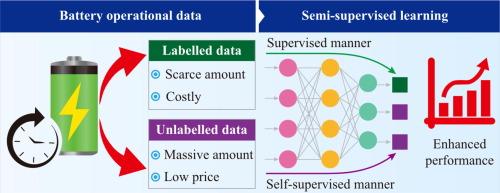Enhanced battery life prediction with reduced data demand via semi-supervised representation learning
IF 13.1
1区 化学
Q1 Energy
引用次数: 0
Abstract
Accurate prediction of the remaining useful life (RUL) is crucial for the design and management of lithium-ion batteries. Although various machine learning models offer promising predictions, one critical but often overlooked challenge is their demand for considerable run-to-failure data for training. Collection of such training data leads to prohibitive testing efforts as the run-to-failure tests can last for years. Here, we propose a semi-supervised representation learning method to enhance prediction accuracy by learning from data without RUL labels. Our approach builds on a sophisticated deep neural network that comprises an encoder and three decoder heads to extract time-dependent representation features from short-term battery operating data regardless of the existence of RUL labels. The approach is validated using three datasets collected from 34 batteries operating under various conditions, encompassing over 19,900 charge and discharge cycles. Our method achieves a root mean squared error (RMSE) within 25 cycles, even when only 1/50 of the training dataset is labelled, representing a reduction of 48% compared to the conventional approach. We also demonstrate the method’s robustness with varying numbers of labelled data and different weights assigned to the three decoder heads. The projection of extracted features in low space reveals that our method effectively learns degradation features from unlabelled data. Our approach highlights the promise of utilising semi-supervised learning to reduce the data demand for reliability monitoring of energy devices.

通过半监督表征学习减少数据需求,提高电池寿命预测能力
准确预测剩余使用寿命(RUL)对于锂离子电池的设计和管理至关重要。虽然各种机器学习模型都能提供有前景的预测,但一个关键但经常被忽视的挑战是,这些模型需要大量的运行至失效数据进行训练。收集这些训练数据会导致测试工作令人望而却步,因为从运行到失效的测试可能会持续数年之久。在此,我们提出了一种半监督表示学习方法,通过从无 RUL 标签的数据中学习来提高预测准确性。我们的方法基于复杂的深度神经网络,该网络由一个编码器和三个解码头组成,可从短期电池运行数据中提取随时间变化的表征特征,而无需考虑是否存在 RUL 标签。我们使用从 34 个在不同条件下工作的电池中收集的三个数据集对该方法进行了验证,这些数据集包含超过 19,900 个充放电周期。即使只有 1/50 的训练数据集被标记,我们的方法也能在 25 个周期内实现均方根误差 (RMSE),与传统方法相比减少了 48%。我们还展示了该方法在使用不同数量的标记数据和分配给三个解码器头的不同权重时的鲁棒性。低空间提取特征的投影显示,我们的方法能有效地从未标明的数据中学习退化特征。我们的方法凸显了利用半监督学习减少能源设备可靠性监测数据需求的前景。
本文章由计算机程序翻译,如有差异,请以英文原文为准。
求助全文
约1分钟内获得全文
求助全文
来源期刊

Journal of Energy Chemistry
CHEMISTRY, APPLIED-CHEMISTRY, PHYSICAL
CiteScore
19.10
自引率
8.40%
发文量
3631
审稿时长
15 days
期刊介绍:
The Journal of Energy Chemistry, the official publication of Science Press and the Dalian Institute of Chemical Physics, Chinese Academy of Sciences, serves as a platform for reporting creative research and innovative applications in energy chemistry. It mainly reports on creative researches and innovative applications of chemical conversions of fossil energy, carbon dioxide, electrochemical energy and hydrogen energy, as well as the conversions of biomass and solar energy related with chemical issues to promote academic exchanges in the field of energy chemistry and to accelerate the exploration, research and development of energy science and technologies.
This journal focuses on original research papers covering various topics within energy chemistry worldwide, including:
Optimized utilization of fossil energy
Hydrogen energy
Conversion and storage of electrochemical energy
Capture, storage, and chemical conversion of carbon dioxide
Materials and nanotechnologies for energy conversion and storage
Chemistry in biomass conversion
Chemistry in the utilization of solar energy
 求助内容:
求助内容: 应助结果提醒方式:
应助结果提醒方式:


